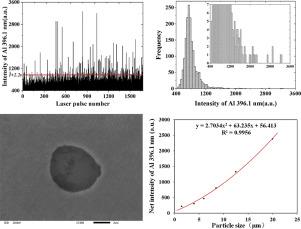当前位置:
X-MOL 学术
›
Spectrochim. Acta B. At. Spectrosc.
›
论文详情
Our official English website, www.x-mol.net, welcomes your
feedback! (Note: you will need to create a separate account there.)
Rapid analysis of content and particle sizes of aluminum inclusions in low and middle alloy steel by laser-induced breakdown spectroscopy
Spectrochimica Acta Part B: Atomic Spectroscopy ( IF 3.2 ) Pub Date : 2020-09-01 , DOI: 10.1016/j.sab.2020.105927 Hui Wang , Yunhai Jia , Yunling Li , Lei Zhao , Chun Yang , Dawei Cheng
Spectrochimica Acta Part B: Atomic Spectroscopy ( IF 3.2 ) Pub Date : 2020-09-01 , DOI: 10.1016/j.sab.2020.105927 Hui Wang , Yunhai Jia , Yunling Li , Lei Zhao , Chun Yang , Dawei Cheng

|
Abstract Non-metallic inclusions affect the mechanical properties of steels. Laser-induced breakdown spectroscopy (LIBS) has the advantages of simple sample preparation, fast analysis, and high spatial resolution. The content and particle sizes of aluminum inclusions in low and middle alloy steel were analyzed by LIBS. Signals of intensities that are higher than the threshold were generated by laser pulses on inclusions. The threshold was calculated cyclically ( I ¯ +ks), where I ¯ is the average intensity, k is a coefficient that is related to the confidence probability, and s is the standard deviation. A content analysis model for aluminum inclusions was established and relates to the number and intensity of the signals. The root mean square error of calibration of inclusion contents for calibration samples is smallest when k = 2.2. The content of aluminum inclusions in the test samples was calculated with k = 2.2, which agrees with that of acid-insoluble aluminum. The relationship between the intensity that was generated by laser pulse on an aluminum inclusion and particle size was deduced, and a quadratic polynomial fit of net intensity and particle size was used. Particle size ranges of ≤3 μm, 3–5 μm, 5–7 μm, 7–10 μm, 10–15 μm, and ≥15 μm for test samples to which spectral signals that correspond to aluminum inclusions belong were determined. The percentages of aluminum inclusions in each particle size range that was obtained by LIBS correspond approximately with the results from scanning electron microscopy coupled with energy dispersive X-ray spectroscopy.
中文翻译:

激光诱导击穿光谱快速分析中低合金钢中铝夹杂物含量及粒径
摘要 非金属夹杂物影响钢的力学性能。激光诱导击穿光谱(LIBS)具有样品制备简单、分析速度快、空间分辨率高等优点。LIBS分析了中低合金钢中铝夹杂物的含量和粒径。强度高于阈值的信号是由激光脉冲在夹杂物上产生的。阈值是循环计算的(I¯+ks),其中I¯是平均强度,k是与置信概率相关的系数,s是标准偏差。建立了铝夹杂物含量分析模型,并与信号的数量和强度有关。当k=2.2时,校准样品夹杂物校准的均方根误差最小。试样中铝夹杂物的含量按k=2.2计算,与酸不溶性铝的含量一致。推导出激光脉冲在铝夹杂物上产生的强度与粒度之间的关系,并使用净强度和粒度的二次多项式拟合。测定了对应于铝夹杂物的光谱信号所属的测试样品的粒径范围≤3 μm、3-5 μm、5-7 μm、7-10 μm、10-15 μm 和≥15 μm。通过 LIBS 获得的每个粒径范围内的铝夹杂物百分比与扫描电子显微镜结合能量色散 X 射线光谱的结果大致相符。这与酸不溶性铝一致。推导出激光脉冲在铝夹杂物上产生的强度与粒度之间的关系,并使用净强度和粒度的二次多项式拟合。测定了对应于铝夹杂物的光谱信号所属的测试样品的粒径范围≤3 μm、3-5 μm、5-7 μm、7-10 μm、10-15 μm 和≥15 μm。通过 LIBS 获得的每个粒径范围内的铝夹杂物的百分比与扫描电子显微镜结合能量色散 X 射线光谱的结果大致相符。这与酸不溶性铝一致。推导出激光脉冲在铝夹杂物上产生的强度与粒度之间的关系,并使用净强度和粒度的二次多项式拟合。测定了对应于铝夹杂物的光谱信号所属的测试样品的粒径范围≤3 μm、3-5 μm、5-7 μm、7-10 μm、10-15 μm 和≥15 μm。通过 LIBS 获得的每个粒径范围内的铝夹杂物百分比与扫描电子显微镜结合能量色散 X 射线光谱的结果大致相符。并且使用了净强度和粒度的二次多项式拟合。测定了对应于铝夹杂物的光谱信号所属的测试样品的粒径范围≤3 μm、3-5 μm、5-7 μm、7-10 μm、10-15 μm 和≥15 μm。通过 LIBS 获得的每个粒径范围内的铝夹杂物的百分比与扫描电子显微镜结合能量色散 X 射线光谱的结果大致相符。并且使用了净强度和粒度的二次多项式拟合。测定了对应于铝夹杂物的光谱信号所属的测试样品的粒径范围≤3 μm、3-5 μm、5-7 μm、7-10 μm、10-15 μm 和≥15 μm。通过 LIBS 获得的每个粒径范围内的铝夹杂物百分比与扫描电子显微镜结合能量色散 X 射线光谱的结果大致相符。
更新日期:2020-09-01
中文翻译:

激光诱导击穿光谱快速分析中低合金钢中铝夹杂物含量及粒径
摘要 非金属夹杂物影响钢的力学性能。激光诱导击穿光谱(LIBS)具有样品制备简单、分析速度快、空间分辨率高等优点。LIBS分析了中低合金钢中铝夹杂物的含量和粒径。强度高于阈值的信号是由激光脉冲在夹杂物上产生的。阈值是循环计算的(I¯+ks),其中I¯是平均强度,k是与置信概率相关的系数,s是标准偏差。建立了铝夹杂物含量分析模型,并与信号的数量和强度有关。当k=2.2时,校准样品夹杂物校准的均方根误差最小。试样中铝夹杂物的含量按k=2.2计算,与酸不溶性铝的含量一致。推导出激光脉冲在铝夹杂物上产生的强度与粒度之间的关系,并使用净强度和粒度的二次多项式拟合。测定了对应于铝夹杂物的光谱信号所属的测试样品的粒径范围≤3 μm、3-5 μm、5-7 μm、7-10 μm、10-15 μm 和≥15 μm。通过 LIBS 获得的每个粒径范围内的铝夹杂物百分比与扫描电子显微镜结合能量色散 X 射线光谱的结果大致相符。这与酸不溶性铝一致。推导出激光脉冲在铝夹杂物上产生的强度与粒度之间的关系,并使用净强度和粒度的二次多项式拟合。测定了对应于铝夹杂物的光谱信号所属的测试样品的粒径范围≤3 μm、3-5 μm、5-7 μm、7-10 μm、10-15 μm 和≥15 μm。通过 LIBS 获得的每个粒径范围内的铝夹杂物的百分比与扫描电子显微镜结合能量色散 X 射线光谱的结果大致相符。这与酸不溶性铝一致。推导出激光脉冲在铝夹杂物上产生的强度与粒度之间的关系,并使用净强度和粒度的二次多项式拟合。测定了对应于铝夹杂物的光谱信号所属的测试样品的粒径范围≤3 μm、3-5 μm、5-7 μm、7-10 μm、10-15 μm 和≥15 μm。通过 LIBS 获得的每个粒径范围内的铝夹杂物百分比与扫描电子显微镜结合能量色散 X 射线光谱的结果大致相符。并且使用了净强度和粒度的二次多项式拟合。测定了对应于铝夹杂物的光谱信号所属的测试样品的粒径范围≤3 μm、3-5 μm、5-7 μm、7-10 μm、10-15 μm 和≥15 μm。通过 LIBS 获得的每个粒径范围内的铝夹杂物的百分比与扫描电子显微镜结合能量色散 X 射线光谱的结果大致相符。并且使用了净强度和粒度的二次多项式拟合。测定了对应于铝夹杂物的光谱信号所属的测试样品的粒径范围≤3 μm、3-5 μm、5-7 μm、7-10 μm、10-15 μm 和≥15 μm。通过 LIBS 获得的每个粒径范围内的铝夹杂物百分比与扫描电子显微镜结合能量色散 X 射线光谱的结果大致相符。











































 京公网安备 11010802027423号
京公网安备 11010802027423号